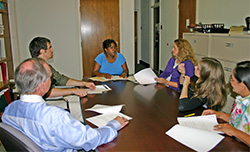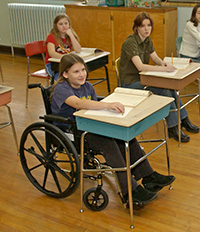What are the roles and responsibilities of school counselors when working with students with disabilities?
Page 2: Participate in the Multidisciplinary Team Process
Target Areas
- Anger management
- Anxiety management
- Assertiveness skills
- Communication skills
- Self-esteem development
- College preparation
- Career development
Collaboration is a critical part of the school counselor’s roles and his or her responsibility to help “all students in the areas of academic development.” Counselors often serve on and provide information and expertise to multidisciplinary teams (sometimes referred to as Individualized Education Planning [IEP] teams) as an extension of their collaborative efforts in working with students with disabilities, but what types of feedback are relevant? Considering that team members are often involved because of their expertise, school counselors should focus on contributing information that others cannot provide due to lack of either skill or knowledge. For example, school counselors’ expertise in general career development and in child and adolescent development will enable them to share important information with multidisciplinary teams. The list to the right contains possible target areas that school counselors may wish to address.
The Multidisciplinary Team
A multidisciplinary team is a group of individuals from multiple disciplines who meet to pursue a common goal, such as evaluating a student for placement in special education or creating an individualized education program (IEP) for a student. Multidisciplinary teams are sometimes referred to as child study teams or student support teams, among other terms. The professional collaboration of a multidisciplinary team, helps ensure that their work regarding students is comprehensive and as unbiased as possible.
Working toward common goals: Evaluation
Multidisciplinary teams who meet to evaluate students for placement in special education have several jobs. They collect several types of data to inform the team about students’ abilities, including:
- Medical history, educational performance, etc.
- Formal assessments, such as intelligence tests or tests of visual or aural acuity
- Informal assessments, such as samples of classroom work and observations of social behavior
- A baseline of performance to guide development of an IEP and determine the effectiveness of subsequent education
IEP Development
An IEP is a customized education plan put in place for students who have disabilities as defined by federal law in the Individuals with Disabilities Education Improvement Act (IDEIA). Multidisciplinary teams who gather to create IEPs should:
- Set goals and objectives.
- Establish benchmarks.
- Design a plan outlining services and supports that will be provided to enable the child to meet his or her educational goals.
(Close this panel)
So that counselors can successfully serve on the multidisciplinary team, it is important that they understand the roles of all people on the team. The multidisciplinary team is usually made up of school and nonschool personnel as well as students’ family members and, when appropriate, the students.
The Team
 One of Mr. Hunter’s roles in working with school personnel and family members on multidisciplinary teams is to help identify goals and expectations for his students. He needs to keep in mind that collaboration with school personnel involves working toward a common goal through the sharing of responsibilities. Members do not have to divide the responsibilities equally but should assign them in some manner on which they agree.
One of Mr. Hunter’s roles in working with school personnel and family members on multidisciplinary teams is to help identify goals and expectations for his students. He needs to keep in mind that collaboration with school personnel involves working toward a common goal through the sharing of responsibilities. Members do not have to divide the responsibilities equally but should assign them in some manner on which they agree.
| Multidisciplinary Team Members | |
| Core Team Members | Role of the Multidisciplinary Team |
| Family member | Offers insight into the strengths, weaknesses, and individual needs of the student |
| At least one general education teacher | Develops goals that support a student’s access to the general education curriculum |
| Representative from the school district | The representative should be:
(In many cases, this is a principal or school counselor.) |
| Someone who can interpret the instructional implications of the assessment results | Presents evaluation outcomes about the student and provides recommendations for the student based on the reported results and input from other team members (In some cases, this may be the school counselor or the school psychologist.) |
| Special education teacher | Develops individualized goals specific to the student’s needs |
| Student (as appropriate) | Identifies the goals that he or she would like to achieve |
Additional team members, such as related service providers (see below), are included at the discretion of the parents or the district and are determined for selection based on the individual needs of the student.
| Related Service Provider | Services Provided |
| Assistive technologist | Supplies high-tech equipment, low-tech aids, and other devices that help compensate for an individual’s disabilities (e.g., speech-to-text translators, holders to keep books open, wheelchairs) |
| Audiologist | Diagnoses hearing losses and auditory problems |
| Social workers, psychologists, guidance counselors, school counselors | Provide individual counseling, group counseling, guidance, and consultation.(School counselors sometimes attend meetings due to the social/ emotional needs of a student, even when they are not fulfilling the role of district representative.) |
| Interpreter | Translates auditory communications into sign language for Deaf students |
| School nurse | Provides and assists with special healthcare needs |
| Occupational therapist (OT) | Directs activities that help improve muscular control and develop self-help skills |
| Orientation & mobility specialist | Teaches students who are blind or who have low-vision how to move through environments, traveling safely and efficiently from one place to another |
| Physical therapist (PT) | Treats physical disabilities and motor problems through many nonmedical means |
| School psychologist, clinical psychologist, educational diagnostician, psychometrician | Administer psychological and educational tests and interpret results |
| Speech/ language pathologist (SLP) | Diagnoses and treats problems in the area of speech and language development |
| Rehabilitation counselor | Assists in preparing individuals with disabilities for the work force via career evaluation, planning, counseling, guidance, and job training |
| Therapeutic physical therapist, recreation specialist | Assess and provide instruction in leisure skills and recreational activities |
| Transportation specialist | Provides travel to and from school, as well as in and around the school itself |
Adapted from Smith (2003)
Activity
 Read about one of Mr. Hunter’s students and write brief answers to the questions below.
Read about one of Mr. Hunter’s students and write brief answers to the questions below.
Megan is a ninth-grade student who has a physical disability that requires her to use a wheelchair. Megan is bright and effervescent and does exceptionally well in school. Although she has made few friends, her teacher believes other students like her. One day, however, Mr. Hunter observes Megan during lunchtime and notices how isolated she seems. He sees that, although some students stop to say “hi” to her, no one sits with her or makes an effort to engage her in conversation. Mr. Hunter speaks briefly with Megan about this, and she indicates that it’s hard to maneuver around the lunchroom to sit with other students. He senses that she is lonely and really wishes she had friends to sit with at lunch.
Mr. Hunter meets with Megan’s teacher to discuss his observations about Megan and her isolation. Megan’s teacher suggests that Mr. Hunter broach the subject during Megan’s next IEP meeting.
- What information should Mr. Hunter present to the multidisciplinary team?
- How should team members contribute to this issue during the multidisciplinary team meeting?
After you have answered these questions, click here to read an expert’s response to this scenario.
Activity: Feedback
Amy Milsom, assistant professor from the University of North Carolina at Greensboro, offers suggestions on how the multidisciplinary team can help Megan.

Amy Milsom, PhD
Assistant professor, The University of North Carolina at Greensboro
Department of Counseling and Educational Development
What information should Mr. Hunter present to the multidisciplinary team?
- During a meeting with the multidisciplinary team, Mr. Hunter expresses concerns about Megan’s lack of involvement with her peers during lunch. He communicates the importance of peer contact not only during the regular school day in the classroom but also during less structured times such as lunch. He believes that Megan wants to be involved with her friends, but needs help to identify ways she can increase her social interactions during lunch. He also believes it is important to help Megan learn to maneuver her wheelchair around the lunchroom to increase her involvement with friends.
How will team members contribute to this issue during the multidisciplinary team meeting?
- Other members of the multidisciplinary team offer their observations about Megan’s social interactions, and it becomes clear that no efforts are being made by anyone (including lunchroom monitors) to involve Megan. The members brainstorm ways to accommodate Megan during lunch and other nonclassroom activities; they identify socially related goals for Megan and a plan to achieve them. Mr. Hunter is identified as the provider responsible for assisting Megan to meet these goals.
Keep in Mind
Once the multidisciplinary team identifies concerns, school counselors may or may not be the best individuals to provide interventions. Nevertheless, bringing personal, social, and career concerns to the attention of the multidisciplinary team is a good place to start. The remaining team members can help to examine the concerns more comprehensively, often by contributing their own observations.